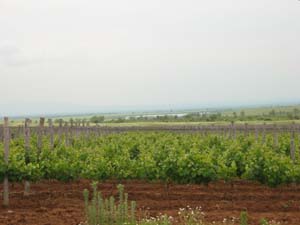| Communist government
nationalized wine production:
With the advent of the Communist government
in 1944 the vineyards and wine production units were nationalised.
The small plots of land, which characterized the wine industry
before the World War II, were nationalized and incorporated
into large, co-operatively managed vineyards. The process
of collectivisation led to incorporation of a large number
of plots and the vineyards belonging to individuals were
reduced from 84 000 ha in 1939 to just 2 200 ha in 1959.
Indigenous grape varieties such as Mavrud,
Melnik, Pamid and Gamza
increasingly gave way to 'international' varieties, such
as Merlot, Cabernet Sauvignon and Chardonnay in an attempt
to move with the rest of the winemaking world. Parallel
with the advances in agriculture, construction of large
wineries commenced. The wine industry was heavily export
oriented and in the 1980-s exports were in the 160-210 million
liters range. Main trading partners were fellow Eastern
European countries, but in the second half of that decade
Western Europe started to gain in importance and share over
the Eastern markets.
New era of Bulgarian wines with
modern attitude:
With the political and economic changes
starting from November 1989, the alcohol monopolies on production,
domestic and international trade in Bulgaria were dismantled
to create the grounding for the development of the private
sector. The vineyards were returned to their original owners,
wineries and the trade were also privatized. Currently the
wine industry is 100% privately managed.
 The
wine industry has gone through very challenging times with
fragmentation of vineyards and grape supply problems. On
the side of wineries, they had to modernise production,
re-define their marketing strategies, secure cash flow and
markets. These problems persisted through the 1990s. While
the Bulgarian wine industry was heavily criticised by international
and local wine professionals for the discrepancy in investment
in vineyards and processing units (with the latter attracting
the lion's share of private money), things look quite different
now. The
wine industry has gone through very challenging times with
fragmentation of vineyards and grape supply problems. On
the side of wineries, they had to modernise production,
re-define their marketing strategies, secure cash flow and
markets. These problems persisted through the 1990s. While
the Bulgarian wine industry was heavily criticised by international
and local wine professionals for the discrepancy in investment
in vineyards and processing units (with the latter attracting
the lion's share of private money), things look quite different
now.
EU funds and private investment from wineries
and agricultural companies have secured more than €100
million for the past four years, which resources were invested
in vineyards. Currently there are 149 registered wine producers
but the number of wineries is steadily going up with medium-sized
and 'boutique' ones being en vogue. Staff training
is also a priority and the know-how is sourced both from
international consultants (David Wollan from Australia,
Michel Roland and Stéphane Derenoncourt from France
are few of the names) and local winemakers, which acquire
hands-on experience, mainly in New World wineries.
Page
1 2 3
|